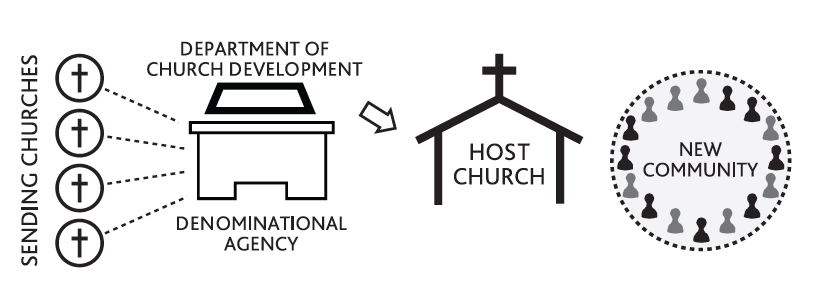Reading: Church Planting Models Part 3
Denominational Model

This is the association kind of model. It occurs when many churches unite in a covenant to start churches, uniting resources and sharing their experience in order to do studies, select areas and set goals for church planting.
Advantages:
a. There is a great deal of available financial resources. The financial burdens are shared.
b. It has an effective administration.
c. There is a wide network of people and ideas available.
Disadvantages:
a. It can leave little room for initiative and participation on a local level.
b. The church planter can feel limited to work within the program established by the denomination.
c. It can create ‘Parochialism’ if leaders lose sight of the needs of other regions.
Cellular Model

This is the way of organizing a church using small groups and meetings in homes as the central axis of the church’s work. It anticipates the multiplication of cells and therefore, of leaders.
Advantages:
a. It promotes the development of leaders.
b. It creates a friendly environment for non-believers.
c. It provides opportunities for more direct interaction.
Disadvantages:
a. If the leadership isn’t dynamic,it tends to kill the church or the church becomes stagnant.
b. It requires a large enough number of leaders to develop the model.
c. It can create resistance to multiplication because of the comfort factor--people bond with others in their group and don’t want to form a new one.
Connections Model
The Send of the Church Plant is in the walk of the Church planter with spouse and family. The church planter invites others to join the reproducible walking with God in a mutually supporting environment. The church planter creates groups of those supporting the walking with God. Soon a worship gathering that supports the walking with God is created to which builds a church.
Advantages:
a. For those that participate their spiritual walk is dramatical strengthened
b. This is very appropriate for bi-vocational church planters
c. The church planters family is very active in the church plant by default
d. The church plant starting in the home fuels the entire church plant
e. The walls faced with a smaller number participates prepare the church planter for leading larger numbers of reproducible leaders.
f. This approach can be easily integrated in to most other approaches
Disadvantages:
a. Some would say this approach is not very programatic
b. This approach though simple is not necessarily easy to maintain
c. This approach does not work well if the church planter's spouse and family are not on board in participating in walking with God.
d. Sometimes this approach avoids the practice of evangelism because of the intense focus of developing strong habits.
REFLECT:
• Which of the church planting models are you most familiar with?
• Which of the church planting models are you using in the church you are presently planting or will you use?
• How can you maximize the advantages of that model?
• How can you compensate for the disadvantages of that model?
Three important ingredients:
ACCOUNTABILITY |
It has been proven in many places that the church planter will have more success when he knows that he has to report to others in a simple, brief way. This report should be turned into his work team, his supervisor, or some advisor who is supporting the church planter in his work.
A MENTOR |
The church planter will be much more successful if he is accompanied by a person who can give him emotional and spiritual support and who is concerned about him and his work. The frequency of visits may vary, but they should not be any less than once a month.
EXTERNAL OR STRUCTURAL SUPPORT |
Studies show that those who have the recognition, nurture and interest of a larger structure or external support have a great advantage over those who work alone. This does not refer to economic support, although at times that is included.
